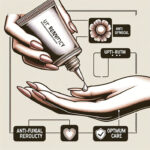Living with Finger Nail Fungus: Long-Term Management Strategies

Getting to Know Finger Nail Fungus
Let’s talk about finger nail fungus—a condition that many people face but often misunderstand. In this guide, we're diving into everything you need to know about handling it for the long haul. We're not just talking about the physical bits and pieces; we’re also discussing how to care for your nails and adjust your lifestyle to keep things in check. Whether you're freshly diagnosed or have had your fair share of flare-ups, it’s important to really understand what’s going on so you can tackle it head-on. We’ll mix in expert tips with down-to-earth advice so that, step by step, you can confidently work toward healthier nails. So, let’s start by exploring what finger nail fungus is all about.
So, What Exactly Is Finger Nail Fungus?
Finger nail fungus, also called onychomycosis, is an infection that mainly messes with your nails. You might notice discoloration, thickened nails, or even nails that crumble or separate from the nail bed. This pesky problem thrives in warm, damp conditions and can sometimes look like other nail infections caused by bacteria or viruses. The fungi responsible can stick around stubbornly, which is why it often requires a well-thought-out, long-term game plan. And while it might seem like just an aesthetic issue, recurring fungus might actually signal other health concerns that need attention.
Spotting the Signs and Symptoms
Catching the early symptoms is key to fighting off finger nail fungus. Common things to watch for include yellow or white spots on your nails, brittle nails, odd nail shapes, or even a lingering odor. Sometimes, you might see the nail slowly lifting away from the nail bed or becoming much thicker—making something as simple as trimming a nail a painful chore. By keeping an eye out for these red flags, you can jump into action with treatment right away, helping to keep the problem from getting worse. Noticing these changes early on guides you in getting the right help, be it self-care or professional advice.
Who’s at Risk?
There are several factors that can put someone at higher risk for finger nail fungus. It often strikes those who are frequently in moist environments, or if your nails have suffered minor injuries. A weakened immune system and chronic conditions like diabetes or psoriasis can also increase your chances. Let’s not forget genetics and overall nail hygiene. Even daily habits—like working in damp or chemical-laden settings—can contribute. Knowing these risk factors helps you take proactive steps, making it easier to prevent this infection or know when it’s time to get professional advice.
How Finger Nail Fungus Is Diagnosed
Getting a Professional Check-Up
When it comes to diagnosing finger nail fungus, seeing a medical professional is a must. Your doctor will start by asking about your symptoms and closely examining your nails. They’ll look at the extent of the damage and rule out other conditions that might mimic a fungal infection. They also consider things like how long you’ve been dealing with it, your exposure to moist environments, and any other health issues you might have. This detailed process is all about making sure you get an accurate diagnosis—and one that fits your specific situation.
Laboratory Work and Imaging
Besides the physical exam, lab tests can provide that extra bit of confirmation. Often, the doctor will take a small scrap or clip from your nail and send it off for microscopic analysis and culture, which helps pinpoint whether it’s indeed a fungus causing the trouble. Sometimes, imaging tests might be needed to see how deep the infection goes or to make sure nothing else is going on. This thorough testing ensures that your treatment plan is not only based on solid evidence but is also tailored to knock the infection out effectively.
Steering Clear of Self-Diagnosis
In today’s world, it’s easy to rely on internet searches and personal anecdotes to diagnose yourself. However, trying to diagnose finger nail fungus on your own can lead to mistakes and might even delay proper treatment. Since many nail issues can look pretty similar, getting a professional opinion is vital. Misidentifying a bacterial or skin condition as a fungal infection can lead you down the wrong road, wasting time and prolonging the discomfort. When in doubt, it’s always best to talk to a healthcare provider before diving into any home remedies or picking up over-the-counter treatments.
Navigating Long-Term Treatment Strategies
The Role of Topical and Oral Medications
The go-to treatment for finger nail fungus usually involves both topical and oral medications. For starters, antifungal creams and lacquers are often applied directly to the nail to tackle mild or moderate infections. When things get more serious, doctors might recommend oral meds like terbinafine or itraconazole, which fight the fungus from the inside out. It’s important to follow your provider’s advice here—these treatments sometimes come with side effects or need careful monitoring. Ultimately, the best approach is one that balances effective medication with good nail care practices.
Exploring Alternative and Natural Remedies
Many people also turn to alternative and natural remedies as part of their long-term strategy against finger nail fungus. Think things like tea tree oil, vinegar soaks, and other essential oils that have antifungal properties. While these remedies can help ease mild symptoms when used alongside traditional treatments, it’s wise to keep your expectations realistic. They can be a nice complement, potentially cutting down the frequency or severity of flare-ups—but be sure to run any natural treatment ideas by your healthcare provider first.
Checking on Progress
Keeping tabs on how well your treatment is working is just as important as starting it in the first place. Regular check-ins with your doctor allow you to monitor improvements in nail color, texture, and overall health. If things aren’t bouncing back as expected, it might be time to tweak your treatment or even combine different approaches. Remember, healing is a marathon, not a sprint. Tracking even the smallest improvements can make a big difference in keeping you motivated on your road to recovery.
Everyday Nail Care and Prevention
Keeping Your Nails Clean and Trimmed
Daily nail care is key to stopping finger nail fungus from taking hold again. Keeping your nails trimmed and clean helps reduce the spots where fungus likes to hide. It’s a simple but effective routine—especially after you’ve been in damp environments. And a little tip: avoid sharing personal nail tools; it helps cut down on the spread of any unwanted infections. In a nutshell, staying on top of your nail hygiene is one of the best ways to fend off fungal problems.
Simple Home-Care Tips
Practical home-care tips can really make a difference in managing and preventing finger nail fungus. Aside from regular cleaning, consider using an antifungal treatment as a preventive measure. Soaking your nails in a mix of water with essential oils or vinegar might also help. Make sure you dry your nails thoroughly afterward—since fungus loves moisture, a dry nail is a happy nail. Investing in a few good-quality, easy-to-clean nail tools can go a long way. Little daily actions add up and can be your secret weapon against recurring infections.
Consider Your Environment and Lifestyle
Your surroundings and everyday habits matter when it comes to preventing nail fungus as well. Spending lots of time in wet, enclosed spaces—like gyms, swimming pools, or communal showers—can increase your risk. Opt for breathable, moisture-wicking socks and gloves to keep your skin and nails in a less inviting state for fungus. Also, don’t underestimate the power of stress management and a balanced diet; a strong immune system is your best defense. Simple changes, such as regularly switching shoes and keeping shared spaces clean, can all help minimize the risk.
Dealing with Recurring Finger Nail Fungus
Noticing Recurrence Patterns
One of the trickiest parts of finger nail fungus is dealing with its tendency to come back. You might notice that even after successful treatment, the fungus can reappear if you don’t address the underlying risks. It helps to keep an eye on your nails for any early signs—like returning discoloration or a slight thickening—and jot down any patterns or triggers you notice. This kind of self-monitoring can offer valuable clues about why it’s recurring and help you adjust your treatment and lifestyle accordingly.
Taking Action Early
When it comes to recurrences, early intervention is your best friend. If you catch a hint of the infection coming back, don’t wait—jump back into antifungal treatments or think about refreshing your nail care routine. Acting fast can reduce the chance of the infection blowing up into something more stubborn. Simple steps like more frequent use of antiseptics or boosting your protective measures when in damp settings can really cut down on treatment time and keep the problem at bay.
Knowing When to Reach Out
Despite your best efforts, sometimes the fungus just won’t quit without a little expert help. If you find that your nails aren’t improving or if the infection starts edging beyond just your nails, it’s a good idea to loop in your healthcare provider. Persistent or widespread infections might hint at other health issues that need specialized care. Staying in touch with your doctor early on helps ensure that you get the right treatment before things get out of hand.
Boosting Your Health Through Nutrition and Lifestyle
Eating Right and Supplement Insights
What you eat plays a more significant role in managing finger nail fungus than you might think. A diet packed with vitamins—especially A, C, and E—can boost your immune system and support healthy nail regeneration. Including lean proteins, whole grains, fruits, and veggies in your meals can give your body the nutrients it needs to fend off fungal invaders. Plus, certain supplements like biotin or zinc are often touted for their role in strengthening nail structure. While food isn’t a cure-all, it really does work hand-in-hand with other treatments to keep your nails in top shape.
Managing Stress and Getting Good Sleep
It might surprise you, but stress and sleep are crucial when it comes to fighting off fungus. A stressed-out body tends to have a weaker immune response, leaving you more open to infections. Practices like meditation, yoga, or simply taking a few deep breaths during your day can help tone down the stress. And don’t forget sleep—your body needs it to repair itself, nails included. A relaxed, well-rested body is far better equipped to resist recurring fungal infections.
Supporting Overall Nail Health
Looking after your nails isn’t just about treatment—it’s about overall care. Regular nail maintenance, a balanced diet, and even minor adjustments like moisturizing and using gentle nail products all contribute to keeping your nails strong. When you’re handling tasks that expose your hands to harsh chemicals or excessive moisture, wearing gloves can preserve your nails’ natural state. This holistic view not only makes your nails more resilient but also stops opportunistic infections from having a chance.
Wrapping It Up: Long-Term Management of Finger Nail Fungus
A Quick Recap of What Works
Handling finger nail fungus might seem like a tough battle, but with a steady, well-rounded approach, it’s definitely manageable. We’ve talked about spotting early symptoms, getting a proper diagnosis, and relying on a mix of treatments—both conventional and natural. Daily care routines, prompt action when symptoms recur, and a focus on nutrition and stress relief all come together to form a solid defense. With the right balance of medical advice and self-care, you can keep your nails healthier and reduce the risks of recurring issues.
Looking Ahead: New Ideas and Improvements
The outlook for managing finger nail fungus is getting brighter as more research rolls in and new treatments and diagnostic tools emerge. The trend is moving toward personalized care that combines traditional medicine with holistic practices. As awareness grows about the links between lifestyle, nutrition, and nail health, comprehensive wellness programs are taking shape. In the coming years, closer collaboration between patients and healthcare providers is likely to lead to even better treatment strategies, so you can look forward to more effective and lasting solutions.





